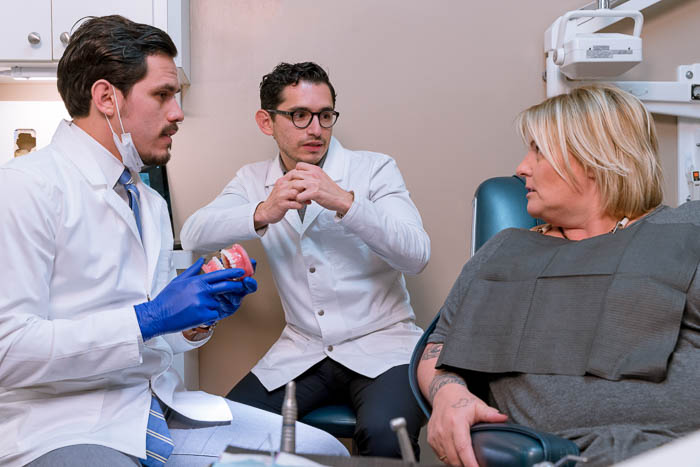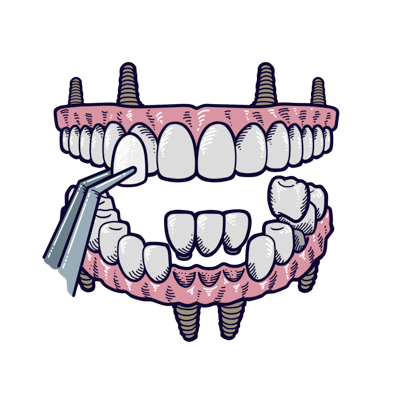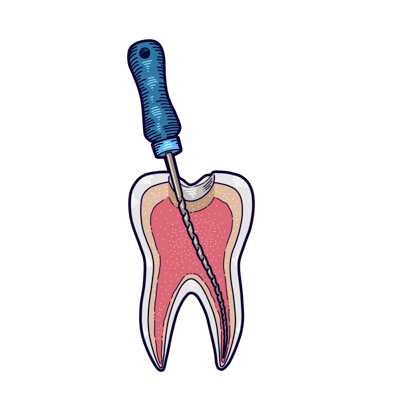Price of
ALL ON 6
DENTAL IMPLANTS
IN MEXICO

Try our Cost & Smile Simulator
from the comfort of your own home.
100% Free. 100% Confidential.


What Are
All on 6 Dental Implants?

How Do All on 6 Implants Compare to All on 4?
What is the primary difference between All on 4 and All on 6 implants?
The primary difference lies in the number of implants used per arch. All on 4 uses four implants strategically placed in the jaw, while All on 6 utilizes six implants. The additional two implants provide enhanced stability and distribution of forces, making All on 6 a better option for patients with low bone density or those who prefer sturdier prosthetics.3
Which system is better for patients with bone loss?
Both systems are suitable for patients with bone loss, but All on 6 is often the preferred choice when bone density is lower because the additional implants provide more surface area for bone integration.4 This can be crucial in preventing future bone loss and ensuring the long-term stability of the prosthesis. However, bone grafting or other preparatory treatments may still be required, depending on the individual’s bone health.5
Can patients switch from All on 4 to All on 6 later?
Yes, it is possible to upgrade from an All on 4 to an All on 6 system if needed. However, this requires additional surgery to place the extra implants and may involve adjustments to the existing prosthesis. This transition is more common if the All on 4 system experiences issues related to bone support or if the patient’s oral health changes over time.
Benefits of All on 6 Implants: Why Choose This Option?
1. Enhanced Stability
With six implants securing the full-arch prosthetic, All on 6 implants provide a more secure and stable foundation, especially when compared to the All on 4 system. This stability is critical for patients with softer bone structure or those who have experienced previous implant failures.
2. Longer-Lasting Solution
All on 6 implants tend to have a longer lifespan due to the even distribution of forces across the arch. The additional implants help reduce stress on each individual implant, which can contribute to the overall longevity of the system.
3. Improved Chewing Function
With six implants, the prosthesis can handle a greater biting force, allowing patients to enjoy a wider variety of foods without concerns about damaging the prosthetic. This improved function is often cited as one of the major advantages over All on 4 implants.6
4. Bone Health and Preservation
All on 6 implants stimulate a larger surface area of the jawbone compared to All on 4, which can promote better bone health and prevent bone resorption. The implants’ strategic placement encourages continuous bone regeneration, reducing the risk of future bone loss.7


Try our online Cost & Smile Simulator from the comfort of your own home.
100% Free. 100% Confidential.
Understanding the Price of All on 6 Dental Implants in Mexico
When choosing All on 6 implants in Mexico, patients can expect a significant price advantage compared to procedures in the USA or Canada. Mexico’s dental market offers world-class services and experienced professionals at a fraction of the price, making it an attractive option for patients seeking cost-effective solutions without compromising quality.
Average Price
All on 6 with Acrylic Prosthesis: Approximately $9,000 per arch.
All on 6 with Porcelain Teeth: Ranges from $11,000 to $14,000 per arch.
All on 6 with Zirconia Bridge: Between $15,000 and $18,000 per arch.
These prices are significantly lower than the average in the USA, where a similar procedure can range from $28,000 USD to $42,000 USD per arch, depending on the materials and complexity of the case.
Average Price
All on 6 with Acrylic Prosthesis: Approximately $9,000 per arch.
All on 6 with Porcelain Teeth: Ranges from $11,000 to $14,000 per arch.
All on 6 with Zirconia Bridge: Between $15,000 and $18,000 per arch.
These prices are significantly lower than the average in the USA, where a similar procedure can range from $28,000 USD to $42,000 USD per arch, depending on the materials and complexity of the case.
Why The Price Difference?
The lower price in Mexico is due to a combination of factors, including lower reduced laboratory fees, and the overall lower cost of living. Despite the lower prices, many Mexican dental clinics invest in the latest technology and adhere to international standards of care, ensuring that patients receive high-quality treatment comparable to what they would find in North America.
Comparing All on 6 Prices:
Mexico vs. USA and Canada
| Procedure | Mexico | USA | Canada |
|---|---|---|---|
| All-on-6 with Acrylic Prosthesis | $9,000 USD | $28,000 USD | $30,000 USD |
| All-on-6 with Porcelain Teeth | $12,500 USD | $35,000 USD | $37,000 USD |
| All-on-6 with Zirconia Bridge | $16,500 USD | $42,000 USD | $45,000 USD |
All on 6 vs. All on 4:
Which One is Right for You?

The All on 6 system provides two additional implants, offering increased stability, better force distribution, and potentially longer-lasting support for the prosthesis. This is especially crucial for patients with compromised bone density or those looking for a more robust solution. Because the forces generated during chewing are spread more evenly across the arch, the All-on-6 can reduce the risk of implant failure and prevent prosthetic fractures, making it an ideal choice for patients who want maximum security for their full-arch restoration.
In contrast, the All on 4 system, while still effective and widely used, offers fewer anchor points for the prosthetic. This means that in cases where bone quality is poor, or the patient has experienced significant bone loss, the All on 4 may not provide the same long-term stability. The key consideration is the patient’s bone health and the ability to withstand the forces applied to the implants over time.
In many cases, patients can receive immediate implant placement, where the implants are inserted at the same time as tooth extractions. This approach, known as "immediate loading," allows for a temporary prosthesis to be attached during the same visit, minimizing downtime and providing immediate aesthetics and function. However, immediate placement is highly dependent on the quality and quantity of bone, as well as the absence of active infections or other complicating factors.
Yes, the All on 6 system is particularly beneficial for supporting heavier and more durable prosthetic materials, such as zirconia. With six implants providing support, there is less risk of the prosthesis shifting or becoming unstable, even under higher masticatory forces. This is why patients opting for zirconia or porcelain, which are heavier and more rigid than acrylic, may find All on 6 to be a superior option.
Both All on 4 and All on 6 can last 20 years or more with proper care. However, the long-term success of either system is highly dependent on maintaining good oral hygiene, regular dental visits, and adherence to the post-treatment guidelines provided by the dentist. Because All-on-6 distributes force more evenly, it may experience fewer complications over time, such as implant overload or prosthetic damage.
Detailed Breakdown
of the All on 6 Procedure
- A thorough dental examination, including panoramic X-rays and 3D CT scans, is conducted.
- The dentist evaluates bone density, gum health, and overall oral health to determine if the patient is a good candidate.
- A personalized treatment plan is created, including the placement of the six implants and any preparatory procedures like bone grafting or sinus lifts.
- Remaining teeth are extracted if necessary.
- Any gum disease or infection is treated to ensure a healthy environment for the implants.
- Bone grafting may be performed if there is insufficient bone to support the implants.
- Local or general anesthesia is administered.
- Six titanium implants are placed in pre-determined positions, ensuring maximum stability and bone integration.
- The implants are angled to avoid anatomical structures like nerves and sinus cavities.
- A temporary, fixed prosthetic is attached immediately, allowing the patient to leave the clinic with functional teeth.
- This temporary set is used until the implants have fully integrated with the bone.
- Healing typically takes 4-6 months, during which the implants fuse with the jawbone.
- Regular follow-ups are necessary to monitor progress and ensure successful integration.
- Once healing is complete, the temporary prosthesis is replaced with a custom-made, permanent prosthetic.
- Patients can choose from acrylic, porcelain, or zirconia for their final set, based on their preferences and budget.

Frequently Asked Questions
Who is a candidate for All on 6 dental implants?
Ideal candidates for All on 6 implants include patients who have lost most or all of their teeth and have sufficient bone density to support six implants. While bone density requirements are slightly higher than for All on 4, many patients who have been told they are not suitable for All on 4 may still be candidates for All on 6 with the help of bone grafting or sinus lifts. A comprehensive evaluation by a dental professional is necessary to determine candidacy.
Can I receive All on 6 implants immediately after tooth extraction?
In many cases, patients can receive immediate implant placement, where the implants are inserted at the same time as tooth extractions. This approach, known as “immediate loading,” allows for a temporary prosthesis to be attached during the same visit, minimizing downtime and providing immediate aesthetics and function. However, immediate placement is highly dependent on the quality and quantity of bone, as well as the absence of active infections or other complicating factors.
What is the price difference between All on 6 and All on 4 in Mexico?
The price difference between All on 6 and All on 4 in Mexico varies depending on the material used for the prosthesis and the specific clinic. On average, All on 6 tends to be approximately $2,000 USD to $3,000 USD more expensive than All on 4 due to the additional implants and increased surgical time. However, for patients who require more support and are concerned about long-term durability, the extra investment may be worthwhile.
How should I care for my All on 6 implants after the procedure?
Tips for Planning Your
Dental Trip to Mexico


Conclusion
All on 6 dental implants in Mexico present a compelling solution for patients seeking full-arch restoration with enhanced stability and long-term success. Compared to the All on 4 system, the All on 6 provides additional support, making it ideal for those with lower bone density or patients who require a more robust prosthetic base.
Visit SOTA Dental today. With significantly lower prices in Mexico, high-quality care, and access to experienced implant specialists, choosing Mexico for All-on-6 implants offers a blend of affordability and excellence.
References
- Oral Health Group: All on X and the Patient Experience
- Cureus: Full Mouth Rehabilitation With All-on-Six Concept With Computer-Aided Design/Computer-Aided Manufacturing (CAD/CAM) Milled Bar Retained Zirconia Prosthesis
- Google Books: Clinical Implantology by Ajay Vikram Singh
- Egyptian Dental Journal: All on 4 Versus All on 6 implant concepts for rehabilitation of edentulous maxilla. Short term randomized clinical and radiographic study
- PubMed Central: Prosthetic Rehabilitation of All-on-Six Implant-Supported Prosthesis: A Case Report
- PubMed: Full Mouth Rehabilitation by Implant Supported Fixed Prosthesis
- JOI: Evaluation of Crestal Bone Loss Around Straight and Tilted Implants in Patients Rehabilitated by Immediate-Loaded Full-Arch All-on-4 or All-on-6: A Prospective Study | Journal of Oral Implantology
- AAID: How do I care for my dental implants?
- NIH: Talking With Your Doctor or Health Care Provider
- Visalogy: Visa Requirements for American Passport Holders – Travel Information for American Citizens




















